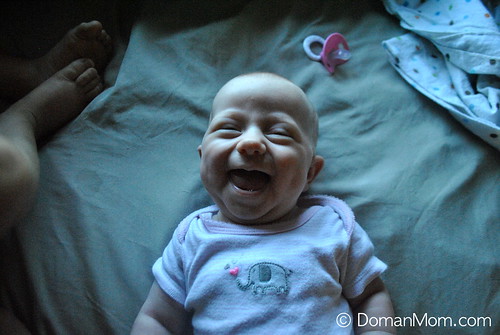
Happy baby
October 27 - November 1, 2014
Age: 5 weeks old
Curriculum: early learning / infant stimulation program outlined in How Smart is Your Baby by Glenn Doman.
Stages she is currently in: Stage III visual (seeing),
Stage II-III auditory (hearing development),
Stage II-III tactile (feeling sensation),
Stage I-II mobility (gross motor movement),
Stage II-III language (speech development),
Stage I-II manual (use of hands).
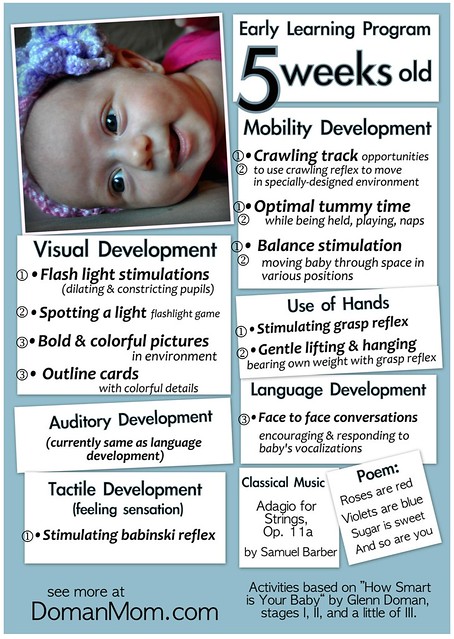
Our activities this week
Above are the activities we did for this week. The little numbers next to the activity tell you what stage or stages the activities coincide with in How Smart is Your Baby.
As you can see, for mobility development she is in stages I-II. The mobility exercises for those two stages are virtually the same.

Looking around in her crawling track
The first is time in her crawling track. She continues to usually enjoy time in her track and most days this week she spent anywhere from 3 to 30 minutes in her track, about 3 to 7 times a day.
There is no real rhyme or reason for that frequency and time length, by the way, that is just my best estimate of what we actually got around to. Ideally a baby will get to spend as much time as enjoyably possible in their track each day.

Aria with her head and arm on the side of the track, "stuck"
Many sessions she gets quite a bit of movement, crawling over a foot. Some sessions she mostly relaxes and doesn't move much at all.
She has spent a lot of time looking around in her track (see first picture) and she also tends to get "stuck" on the side of her track quite often, when her head and arm get wedged into the side and it is difficult for her to move. She understandably gets quite frustrated when this happens.
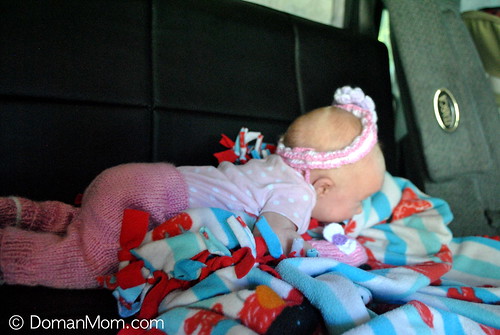
She prefers to be on her stomach rather than on her back
One funny thing that I realized about her is that she actually prefers to be on her stomach over being on her back.
For most babies, both of my older boys included, tummy time is somewhat of a struggle and they don't like to be on their stomaches for too long.
With Aria, however, I will sometimes lie her down on her back and she will start fussing, and flipping her over to her stomach will actually make her stop!
Balance:
She continues to enjoy her balance activities, and they usually relax her, as long as she's not too tired.
I don't have any pictures of them this week. I did finish shooting a how-to video of her balance activities though, and now I just have to compile them together and upload them.
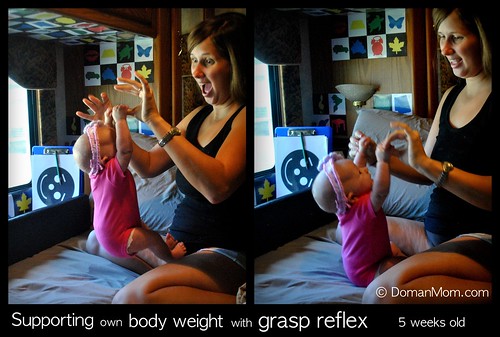
Milestone: she can support her own body weight with her grasp reflex now
Manual (Use of Hands)
She reached a new milestone in her use of hands development this week and can support her own body weight. Hooray!
Since birth I have been stimulating the grasp reflex, with the slightest amount of lifting worked in to get progressively higher.
For instance, when she was a few days old I would get her to grasp my thumbs and then lift her to where her head was maybe a half inch off of the bed.
Over the weeks we got progressively higher, to where she was eventually being lifted to a sitting position, then to a standing position, now she is to the point where her grasp reflex is strong enough that she can be lifted off of the bed for a few seconds.
She enjoys this as long as I keep it brief. If I hold her like this for more than a about 2 seconds she will start crying. So I always keep it very brief so she will continue to enjoy it.
As you can see from the activity list above we still do your basic grasp reflex stimulation from stage I, usually while she is nursing I will play with her hands and she will hold onto mine.
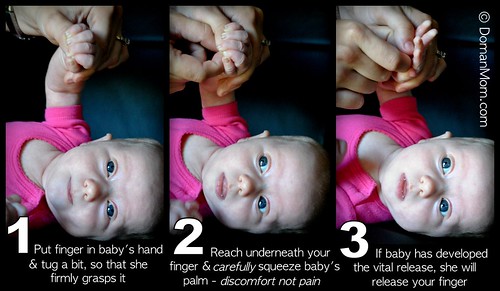
How to test the vital release
Another thing we did this week for her manual (use of hands) activities was to test her vital release.
I did not list this as an activity because we only did it a few times, although I may list it for next week because she was not entirely consistent in her response so I may do the stimulations to help her develop this ability to a more consistent point.
The vital release is, essentially, the ability to let go. When babies are born, as we all know, they have a grasp reflex. They reflexively grasp onto anything place in their hand.
However, they do not actually have the ability to release the grasp, even if the thing that they are grasping is causing them pain or discomfort.
Eventually, though, they will develop the vital (aka lifesaving) release, which is the ability to release their grasp if whatever is in their hand is uncomfortable or painful. This is the prerequisite to being able to voluntarily open and close their hand and pick things up with their hands.
So to test her vital release, I did as instructed in the picture above. Basically, I put my thumb in her hand and allowed her to firmly grasp it. Then, I ever so carefully squeezed a fold of her skin from underneath my thumb.
I squeezed it enough to bring about discomfort, but obviously I am not trying to hurt my baby so I was not squeezing it to the point of pain. If the baby has developed the vital release, she will let go when you are making her uncomfortable. You might make the baby get a grouchy look or cringe, but ideally not cry.
If she hasn't developed the vital release yet she may start crying but still not let go.
Aria did have the vital release, but it is not yet very consistent. I would sometimes have to squeeze a couple of times before I got a response. A couple of times she started stirring as if she felt something but did not let go. So I think I will strengthen this brain pathway more next week.
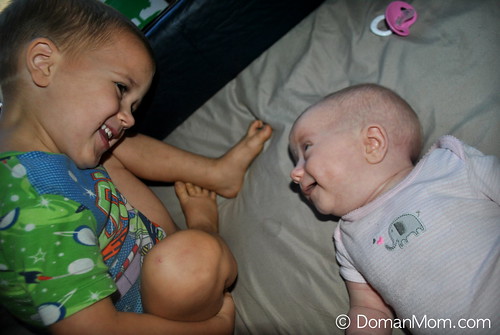
Damien (age 3) having a conversation with Aria. He loves repeating her poem for her, too.
Language Development:
Now that Aria is very, very consistently smiling at us, it makes our conversation sessions so much more fun.
For language development we have lots of back and forth conversations. That is, not just talking to baby but talking with her: responding to her when she talks to us (all sounds are language), asking questions (and actually waiting for a response), and so on.
We also have been doing our poem: "Roses are red, violets are blue, sugar is sweet, and so are you."
Theoretically I am supposed to repeat this poem 5x a day for the first week, then the next week I repeat it but "drop" (don't say) the last word of the poem (in this case, "you") and encourage the baby to say that word "you" (of course, she doesn't have to make that exact sound, any sound will do).
But I haven't been that consistent, more like just repeating the poem randomly when I think about it. But hopefully next week...
She has been "talking" a lot lately, definitely has developed or is developing stage III language development, "the creation of meaningful sounds".

Aria looking at a stage III flash card
Visual Development
This week was kind of a funny week for visual development. She is technically in stage III, but we haven't really started a full stage III visual program yet, due to the fact that I had this set date of starting stage III when she was 6 weeks old and I didn't really want to divert from that schedule.
Sort of silly, yes, but when I had the entire first year mapped out, it would kind of throw it off. So I waited.
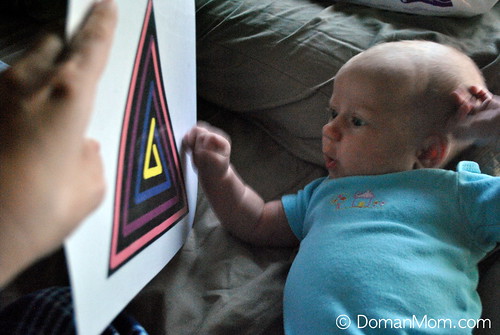
Aria checking out a stage III flash card of a triangle
I did go ahead and introduce her to a few stage III flash cards, though, and she seemed to enjoy them.
We also continued to do stage I flashlight stimulations, and the stage II "spotting a light" in the dark flashlight game.
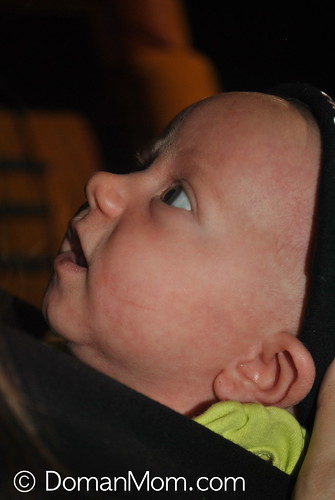
Aria, in her Moby Wrap, checking out my face at a fall festival
We also went to two different fall festivals this week, as well as trick or treating, and she enjoyed looking at all of the lights at both activities. It was a great opportunity for her to use her vision.
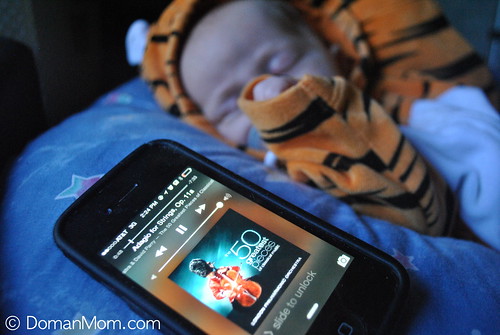
Aria listening to classical music while napping on the boppy
Auditory Program
Our auditory program involved the language program (described above), as well as listening to classical music (this week's piece was Adagio for Strings, Op. 11a).
You may have noticed that we skipped over stage II auditory activities, and I will describe our reasoning for that in another post.
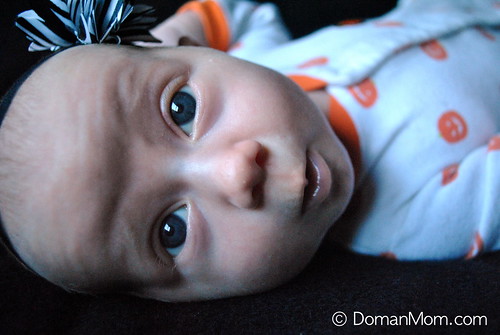
Little pumpkin
Tactile Program
We also skipped the stage II tactile program, but are continuing to do the stage I activity of stimulating the babinski reflex.
If I would have thought of it before now, I should have just gone onto the stage III tactile program (tickling and massage), but I didn't. Oh well, will start that next week.
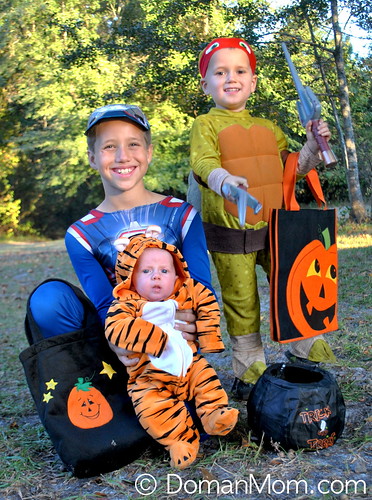
Happy Halloween!
This is what her developmental profile currently looks like:

Resources used this week:
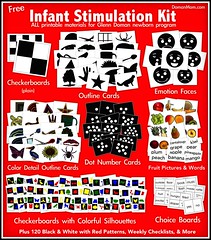

2014/11/04 at 10:43 pm
ReplyDeleteHi Elizabeth,
These pictures are adorable and amazing!! Thank you for sharing your experience and insight. It is inspiring to follow the incredible progress your lovely daughter is making. You are doing a wonderful job! Your children are so lucky to have such a dedicated mother.
Keep enjoying these precious moments!
My very best to you all,
Maria